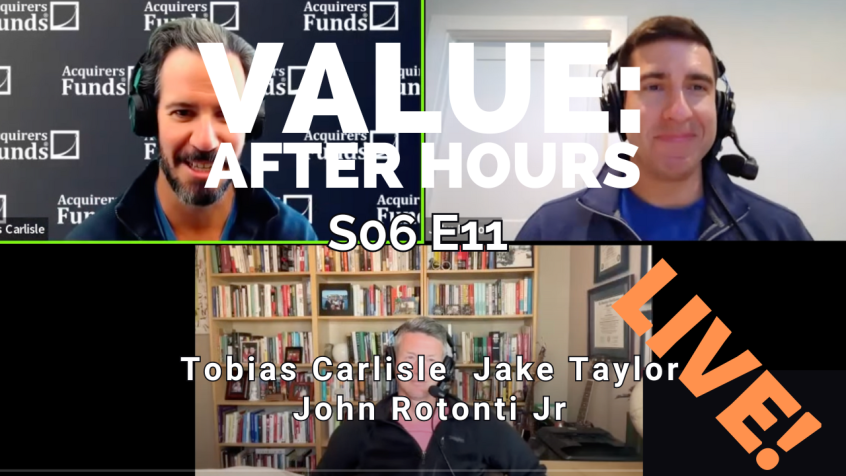During their latest episode of the VALUE: After Hours Podcast, Carlisle, Taylor, and John Rotonti Jr discussed The Nygren Effect: 6x PE + Share Repurchases = 20% EPS Growth. Here’s an excerpt from the episode:
John: So, the way you asked the question, Tobias was, do you think value investor returns have largely come from that? No. [crosstalk]
Tobias: I said. Yeah. Is that the traditional expectation?
John: Right. So, I think the philosophy and where the returns actually came for may be different. I think the philosophy was at a large margin of safety, buying a dollar for 50 cents with the expectation that it’s eventually going to be valued at a dollar. Was that an expectation of traditional value investors that the margin of safety would close? And so, you buy it when it’s trading at 50 cents on the dollar. And then if you’re right, you start to sell when it’s trading at 90 cents on the dollar. And then, you’re out by the time it’s a dollar. [crosstalk] dollar.
Tobias: Give the example of Nygren’s six times earnings.
John: Right. And so, in the real world, I did say– [crosstalk]
Tobias: I think we talked about that offline. Talk about the– Do that calculation for everybody.
John: Absolutely. So, in my most recent print interview with Bill Nygren, he says, “If the cash conversion rate is 100%, the company could reduce shares outstanding by 17% annually and grow per share value by 20%.” Just to recap, he’s saying six times PE, business value is flat. Earnings are not growing, they’re just stable. Free cash flow conversion to net income is one times or 100%. In that scenario, the company could reduce shares outstanding by 17% annually and grow per share value by 20%.
So, earnings per share are growing by 20% even though net income is growing 0%. And [crosstalk] Mauboussinput out a white paper like a week ago, maybe two weeks ago, talking about this very thing, how low PEs can drive massive EPS growth when you’re buying at a discount.
Tobias: So, let’s keep this thought experiment going. Let’s say I own stock in a company that’s doing that, and it buys back stock. And eventually, it buys back all of the outstanding stock, and I’m the only person left. Do I care where the bid is in the market, or am I getting the intrinsic flows that are far superior to anything that I’ve ever paid?
John: This wasn’t planned. So, in the same interview–
Jake: Nothing is on this show.
John: Right. No, I love this. [Tobias laughs] In the same interview, Bill Nygren says, “If a company generates a lot of excess cash and buys back stock when the valuation is too low, that eventually forces the valuation higher.” So, there’s a forcing mechanism. So, Tobias and Jake, so think about it.
Tobias: I don’t even need a, “I’m saying I like this thing.”
John: I love this thing. Let’s use easy math. I can go through the math of the 17%, the 20%, if you all want, because I broke it out for a student that I mentor. [Tobias coughs] But let’s do it.
Tobias: Let’s do it. Let’s break it out.
John: So, it’ll just take me a second. I have it right here. So, let’s assume zero debt. So, interest expense is zero. EBIT is $125, tax rate is 20%, assume 100 shares outstanding. Tax rate is 20%. So, 20% of $125 is $25 in taxes. So, net income is $100.
We also know, based on the Nygren quote, that free cash flow is at least $100, because free cash flow conversion is 100%. So, he gave us a PE of six. So, PE of six, we know that net income is $100. So, six times $100, we know the market value is $600. So, we have a market cap of $600, a 100 shares outstanding, so stock price is six.
Now, you repurchase 17% of 100 shares outstanding, which means you buy back 17 shares for $102. 17 shares times the $6 per share stock price, okay? That’s $102. So, you spent all of your free cash flow. Free cash flow was $100. In this example, we’re saying $102.
Net income is still $100, because remember, he said earnings are stable or flat, and buybacks come out of distributable or free cash flow, not from net income. So, net income is still $100, shares outstanding are now 83. We started with 100 shares, we bought back 17, we now have 83 shares outstanding. So, original EPS was $1. Net income of $100 divided by 100 shares outstanding, $1. The new EPS after the buyback is $120. Net income of still $100, now divided by 83 shares outstanding. That’s a $1.20.
So, EPS went from a $1 to a $1.20. You get 20% growth in earnings per share when you buy back 17% of the shares when the PE is six. Net income did not grow one penny. So, that’s the power of buybacks at low PEs or high free cash flow yields.
You can find out more about the VALUE: After Hours Podcast here – VALUE: After Hours Podcast. You can also listen to the podcast on your favorite podcast platforms here:
For all the latest news and podcasts, join our free newsletter here.
Don’t forget to check out our FREE Large Cap 1000 – Stock Screener, here at The Acquirer’s Multiple:




One Comment on “The Nygren Effect: 6x PE + Share Repurchases = 20% EPS Growth”
Didn’t work out so well for IBM